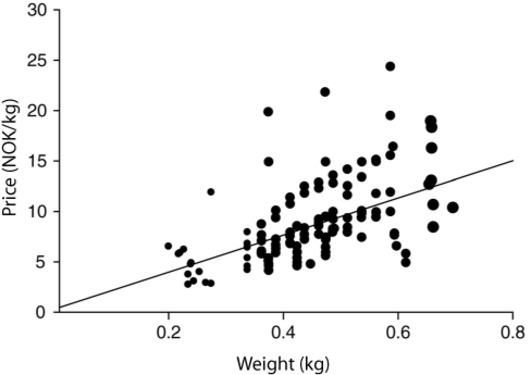The cost of evolution
What value is lost when fish evolve to smaller sizes, and how does this affect optimal harvest strategies?

Main content
Considering the positive relationship between market prices and fish size, we want to examine how economic benefits of a fishery are affected when fish evolve to lower maturation ages and smaller sizes, and whether this interaction of fishing-induced evolution and size-dependent prices influences optimal harvest strategies.
Background
Commercial fisheries impose intense mortality on fish stocks, diminishing the survival probabilities for big, old fish substantially. Growing to large sizes and maturing late loses its evolutionary benefits, instead fishing selects for early maturing, small individuals. Yet the big fish are the most valuable ones for the stock and fishermen alike: Their reproductive output is a strong driver of stock productivity and stability, and they yield generally higher market prices than smaller fish. Size-dependent pricing, commonly with a positive relationship between fish size and price per kilogram, is widespread in industrial fisheries and influences how fish stocks should be harvested to achieve an economically optimal result.
Existing studies have shown how fishing-induced evolution may affect stock dynamics and also catch, but economic consequences are rarely considered. However, the bioeconomic perspective is crucial for successful management, and size-dependent pricing may be of particular relevance in this context: Smaller fish in the stock mean smaller fish in the catch that yield disproportionally less money on the market. Potential consequences of fishing-induced evolution for fisheries are therefore not limited to economic losses due to less quantity of catch, but decreasing mean catch sizes could further enhance these negative effects in the context of size-dependent pricing. To assess how size-dependent pricing influences an evolutionary impact assessment may provide important insights for adequate management strategies.
This project will be part of the fisheries bioeconomics and management activity at EvoFish.
Objectives
Analyse the impact of fishing-induced evolution under size-dependent pricing on economic yield and optimal harvest strategy.
Hypothesis
Current size-selective fishing leads to selection pressure towards early maturing, smaller individuals in fish stocks and subsequently the catch. Given that price depends on fish size, fishing-induced evolution will lead to additional costs besides reduced biological yield and influence how a fish stock should be harvested to maximize profit.
Methods
A bioeconomic life-history model of North-east Artic cod will be developed further to include size-dependent pricing and the necessary components to analyse the influence on optimal harvest strategies.
Supervision
Fabian Zimmermann and Mikko Heino
Further reading
Conover, D. O., and S. B. Munch. 2002. Sustaining fisheries yields over evolutionary time scales. Science 297:94–96. doi: 10.1126/science.1074085.
Heino, M., L. Baulier, D. S. Boukal, B. Ernande, F. D. Johnston, F. M. Mollet, H. Pardoe, N., et al. 2013. Can fisheries-induced evolution shift reference points for fisheries management? ICES Journal of Marine Science. 70:707–721. doi: 10.1093/icesjms/fst077. Free access link. Open access!
Laugen, A. T., G. H. Engelhard, R. Whitlock, R. Arlinghaus, D. J. Dankel, E. S. Dunlop, A. M. Eikeset, et al. 2014. Evolutionary impact assessment: accounting for evolutionary consequences of fishing in an ecosystem approach to fisheries management. Fish and Fisheries 15:65–96. doi: 10.1111/faf.12007.
Zimmermann, F., M. Heino, and S. I. Steinshamn. 2011. Does size matter? A bioeconomic perspective on optimal harvesting when price is size-dependent.Canadian Journal of Fisheries and Aquatic Sciences 68:1651-1659. doi:10.1139/f2011-093.Zimmermann, F., and M. Heino. 2013. Is size-dependent pricing prevalent in fisheries? The case of Norwegian demersal and pelagic fisheries. ICES Journal of Marine Science 70:1389–1395. doi: 10.1093/icesjms/fst121. Free access link.
